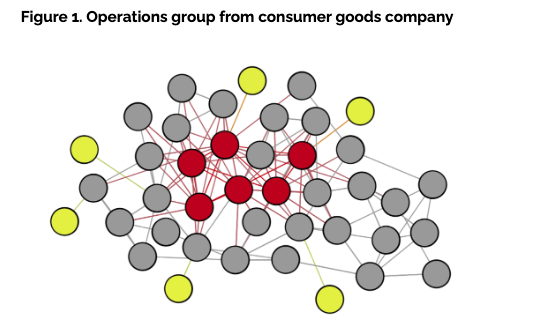
by admin | Jul 23, 2025 | Human Resources
 When considering employee retention, HR professionals must realize that turnover doesn’t begin with a resignation letter. It starts much earlier—and it’s quieter. A skipped lunch, a missed meeting, fewer Slack messages. These small signs often signal something much bigger: an employee pulling away. Long before someone quits, they disconnect. And in today’s networked workplace, social withdrawal is often the first—and most reliable—indicator that someone’s already halfway out the door.
When considering employee retention, HR professionals must realize that turnover doesn’t begin with a resignation letter. It starts much earlier—and it’s quieter. A skipped lunch, a missed meeting, fewer Slack messages. These small signs often signal something much bigger: an employee pulling away. Long before someone quits, they disconnect. And in today’s networked workplace, social withdrawal is often the first—and most reliable—indicator that someone’s already halfway out the door.
While voluntary turnover has dropped to 13.5 percent—a sharp decline from 24.7 percent in 2022—that doesn’t mean employees are engaged. According to Gallup, more than half of U.S. workers are either actively searching or watching for new jobs. One in three say they’re ready to quit—even without something else lined up. This isn’t just dissatisfaction. It’s detachment. And it’s quietly reshaping our workforce.
Gallup calls this the “Great Detachment.” Employees are still showing up—but they’ve stopped buying in. They’re physically present, but relationally and emotionally checked out. And if left unchecked, this detachment becomes the precursor to departure.
Employee retention: Why people leave before they leave
Network analysis has consistently identified one of the most powerful—and overlooked—predictors of employee turnover: social isolation. While compensation, career mobility, and flexibility certainly matter, they rarely tell the whole story. People don’t just leave because of what they’re missing in their role. They leave because of what they’re missing in their relationships. When employees feel disconnected from their peers, excluded from informal conversations, or cut off from trusted collaborators, a sense of belonging erodes. And once that sense of belonging fades, disengagement—and eventual departure—often follows.
Employees on the edge of the network—those with limited connections—are two to three times more likely to quit. Without strong ties, they’re often left out of critical conversations, informal support, and growth opportunities. In fact, disengagement typically begins at the edges, long before it shows up anywhere else.
But a new pattern is emerging inside organizations: some employees aren’t just stuck on the edges—they’re choosing to move there. They’re intentionally stepping back from collaboration, reducing their interactions, and moving to the periphery of the network by design rather than by default.
Just consider the organization below, it represents an operations group of just over 40 employees within a global consumer goods company, a network analysis revealed a disturbing trend. Six employees—represented in yellow nodes (Figure 1)—were only connected to one other colleague. Several more had just two connections. And while that level of isolation is concerning on its own, what made it worse was that nearly half of these individuals were previously well-connected just a year earlier. They hadn’t just become isolated. They had chosen to pull back.

A recent study from Thred provided even more compelling evidence: employees who had recently resigned had 36 percent fewer connections than the company average. Even more telling, they were twice as likely to report having no meaningful friendship relationships at work. These findings point to a deeper insight—relational connectedness is more than a cultural asset; it’s a predictive signal. Building strong interpersonal ties may be one of the most underutilized levers in improving employee retention.
The contagious nature of the center
Research has long shown that employees at the center of an organizational network—those with many active connections—are 24 percent less likely to leave. These individuals, much like the red nodes in Figure 1, are deeply embedded and often serve as the glue that holds teams together. Their centrality provides access to information, influence and support.
And when those connections go beyond the professional—when they include genuine friendships—their likelihood of staying increases even more. Research has found that employees engaged in dual-purpose relationships—blending both professional collaboration and personal rapport—were 37 percent less likely to quit than those with purely transactional ties. When relationships go beyond the task at hand, people are more likely to stay—not just for the work, but for the sense of shared connection.
But here’s where it gets more complex. When well-connected, central employees become burned out, disengaged or disillusioned with the organization’s direction, their influence can shift from stabilizing to destabilizing. According to Thred’s research, when a central employee leaves, as much as 25 percent of their immediate network is likely to follow within months. These aren’t isolated exits—they’re relational chain reactions.
In highly collaborative environments, the ripple effect of a single departure can quickly cascade across a team. Employees who leave often hold more than just a role—they serve as connectors, mentors and informal leaders whose influence stretches far beyond their job title. When they exit, it disrupts not only workflows but the underlying trust networks that hold teams together. Like a contagion, quitting spreads through connection: the closer someone is to a departing colleague, the more likely they are to re-evaluate their own sense of belonging, purpose, and place within the organization.
The effect can cascade across teams, departments and even geographies—especially in highly collaborative organizations. Like a virus, quitting spreads through proximity. The closer you are to someone who leaves, the more likely you are to consider it too.
What HR can—and should—do
For HR leaders, the implications are clear: employee connection is no longer a soft metric. It’s a strategic one. The good news? Relationships are something organizations can influence—with intention.
Here are four high-impact ways to foster friendship—and reduce attrition:
1. Use network analysis to spot flight risk early
Conduct regular organizational network analysis to identify employees with few or declining connections. These individuals are not just disengaged—they’re already on their way out. Early detection can inform re-engagement strategies or personalized outreach. And if you can’t run an analysis, just watch. Notice who is leaning back more often than they used to.
2. Facilitate moments of connection
Friendship doesn’t form by accident—especially in hybrid or remote settings. Use tools like interest-based matching (for example, Thred’s Stitches) to facilitate meaningful one-to-one meetups. Host curated mixers, team swaps or mentorship pairings that prioritize human connection, not just transactional interactions.
3. Support relationship-rich teams
Encourage cross-functional initiatives where both personal rapport and professional trust can develop. Invest in psychologically safe team cultures that allow for vulnerability, shared experience and the blending of professional and personal interest.
4. Routinely pulse check with central employees
Central employees with high trust capital have the greatest influence on the network. If they’re thriving, they’ll lift others with them. But if they’re frustrated or burned out, their exit could trigger a talent drain. Keep these employees close—and engaged.
By Michael Arena
Originally posted on HR Exchange Network

by admin | Jun 5, 2023 | Employee Benefits, Human Resources
 Total rewards packages refer to the compensation and benefits plans that companies offer. This phrase, however, extends beyond mere salary or wages and traditional benefits, like health insurance, to provide both recruits and employees with a rundown of what makes the employer special. Some in Human Resources might regard the total rewards package as the starting line for employee value proposition (EVP).
Total rewards packages refer to the compensation and benefits plans that companies offer. This phrase, however, extends beyond mere salary or wages and traditional benefits, like health insurance, to provide both recruits and employees with a rundown of what makes the employer special. Some in Human Resources might regard the total rewards package as the starting line for employee value proposition (EVP).
Here are the different components of a total rewards package:
Compensation
Compensation, which may refer to wages or salary, is the obvious main feature of the total rewards package. People get paid for their work, so they can afford housing, food, and the basic necessities of life. The money you’re paid to work may include the chance for bonuses and other merit-based rewards, in addition to salary or wages.
Basic Benefits
The most well-known benefits include health, vision, and dental insurance. People have come to expect some form of medical insurance for full-time employment in the United States. In fact, most rely on this benefit for their healthcare because private insurance is astronomically expensive without group membership, and the United States does not have a public option.
Retirement Plans
Offering 401(k) or IRA plans have also become the norm. Companies previously rewarded loyalty with pensions that could help people survive after employment ended. However, nowadays, pensions have been replaced by these other retirement plans, which rely on sometimes volatile markets. There are penalties for taking the money out of such accounts before retirement.
Paid Time Off (PTO)
Paid time off is not a given in every job. However, it refers to the time people are allowed to take vacation, recover from illness or injury, and celebrate holidays while still getting paid. This can include vacation days, sick days, and bank holidays.
Nowadays, some companies are getting creative with PTO. They may include shared days off, where the entire organization takes a break and gets paid. Or they might have unlimited PTO, which means people do not have to accrue or earn days based on seniority. Rather, they can take off when they need to without limit. In those cases, however, employers use an honor system to ensure people do not take advantage of the system.
Family Leave
This is key for new parents, those tending to loved ones who are ill or elderly, or those facing a longer-term illness themselves because they can take time off for care. However, family leave does not have to be paid. Approved family leave requires employers to hold the position for the person, but they do not have to be paid during that time off. It depends on whether they company offers pay for family leave. Many do pay for maternity leave for up to three months, and many others are offering paternity leave now, too. Assessing employment law is a necessity in these cases. And job applicants must do their due diligence when vetting potential employers if they think they may need leave at some point.
Learning and Development and Career Paths
Employees are seeking opportunities to learn, grow, and develop in their careers while on the job. Therefore, more employers are trying to offer training, classes, reimbursement for tuition or coursework, mentorship, leadership development, and other opportunities to gain skills necessary for raises and promotions. It will also help the individual and the employer remain relevant as the skills gap becomes more of a problem in the future of work.
Mental Health and Wellness Programs
For decades now, people have looked to their employers for gyms or gym membership. But now everyone is thinking beyond physical health to mental health as well. As a result, access to mental health help, employee assistance programs (EAPs), classes on mindfulness or yoga, apps for stress management, and more are on the table. Many employers are responding with a wealth of benefits related to wellness and well-being.
Free Food
Providing free lunches, snacks, or special occasion treats has been a hallmark of American companies. Many of the tech giants have campuses that provide services from dry cleaning to dental work, and free food in the cafeteria is a given. As employers try to convince people to return to the office in this post-pandemic era, they try to lure them with bagels or pizza or even other more gourmet options.
Work-Life Balance
Flexibility in where and/or when people work is going mainstream. As the gig economy gains steam, people expect to have more flexibility in their scheduling. Offering remote or hybrid work schedules, understanding when someone must pick up their kid from school or go to a doctor’s appointment, and allowing people to execute asynchronous work during off hours are benefits that impact work-life balance.
Ultimately, the total rewards package a company offers is the first sign of its relationship with employees. It tells the story of how talent is valued by an organization. It usually requires more than just money to satisfy recruits and employees.
By Francesca Di Meglio
Originally posted on HR Exchange Network

by admin | Feb 27, 2023 | Human Resources
 Employee engagement is the top priority of respondents to HR Exchange Network’s latest State of HR survey. Obviously, employers are keen to engage employees to increase productivity and retention. However, the economic downturn and inflation is complicating matters, and Human Resources leaders are seeking new ways to reach talent.
Employee engagement is the top priority of respondents to HR Exchange Network’s latest State of HR survey. Obviously, employers are keen to engage employees to increase productivity and retention. However, the economic downturn and inflation is complicating matters, and Human Resources leaders are seeking new ways to reach talent.
Recently, Eric Mochnacz, strategic senior HR leader and Director of Operations at Red Clover, shared his ideas about how to move forward and keep morale up, even in lean times. Here’s what he had to say:
HREN: First of all, do you think employees are going to continue with the leverage that they have? Or is that going to shift again?
EM: We’ve argued that it’s a job seekers market. Job candidates and employees can demand more. I think job seekers are more in the driver’s seat. However, they will probably come to future employers with more reasonable expectations. Recently, I got into it on LinkedIn with an individual who was honest. He said that if you were in talent acquisition, and you were making x amount of dollars, you have to be realistic about what some of these companies are willing to offer you. You may need to take a salary cut.
Obviously, we want people to feel like they are paid their worth. But I think what happened – and this is true for many of our clients – is they were getting people stolen from them because these companies were just throwing an exorbitant amount of money to win talent. That’s where a lot of people got burned.
Employees and job seekers will have the opportunity to say, ‘Listen, I still want remote work. I still want flexible scheduling. I think that’s still a good negotiating point for people. I think where employers will get savvier is that they will not throw money at job candidates like they did before. They’re going to be a little more conservative. Job seekers will have more realistic expectations about what they’re going to be able to find. If you’re from Meta or Twitter, when you think about becoming a software engineer at a 10- to 15-person firm, you must realize that they probably cannot afford what Meta and Twitter were able to provide.
However, we tell our tech clients to remind people that they will have a constant stream of customers, so they can offer job security. That’s the difference.
HREN: What are some of the best practices for employee engagement to keep productivity and morale up?
EM: It’s critical that how they communicate from this point on with employees helps them understand their standing in the organization. There’s been a lot of hot takes, and I’ve participated in some about how Elon Musk handled Twitter versus how Mark Zuckerberg handled Facebook.
If the company ultimately believes that the decisions they make will right set the organization, and they don’t think they’re going to need to make any layoffs in the near future, HR should say, ‘Listen, this was why we did X, Y, and Z. We think we will be successful in addressing the problem. We are relatively confident that we won’t need to do another round of layoffs.’ Again, nothing is ever guaranteed. I also think it probably requires HR leaders to get a little more face time with employees.
There’s probably this pervasive feeling of I’m doing more with less, and I’m not going to have the opportunity to find someone to relieve some of the work pressure. So, what are we doing? What’s the company doing? What are we doing to look forward? HR – I hope it’s part of the strategic leadership team – should be able to adequately respond to those questions. They must be able to listen and say, ‘So, you’re saying that you’ve now taken on the work of two other people, because we let them go? The solution to this problem is that we need to show your value. We don’t want to lose you.’
What needs to happen? I think it’s just more intentional communication with the remaining workforce, helping them feel valued, really listening to what they have to say. Then, you must use that to develop strategy into Q1 and Q2. Continue to communicate that effectively. Say, ‘We can’t hire more people now, but if things adjust, we might be able to do so in the next quarter.’
By Francesca Di Meglio
Originally posted on HR Exchange Network

by admin | Feb 13, 2023 | Human Resources
 There aren’t rules for how frequently you should update your handbook, but given laws do change, it’s smart to be proactive so you don’t get caught off guard.
There aren’t rules for how frequently you should update your handbook, but given laws do change, it’s smart to be proactive so you don’t get caught off guard.
An updated employee handbook helps employees understand what’s expected of them, and helps managers ensure company policies are followed.
We’ve identified four reasons to revisit your employee handbook in 2023.
New year, new employee handbook? There aren’t any hard and fast rules that require your handbook to be updated at specific intervals. But instead of assuming it’ll get you through 2023, there are good reasons to treat it like the living document it is.
First, the implementation of updated, clear policies that both employees can understand, and managers apply consistently will help employees feel like they’re being treated fairly.
Next, having a handbook that you know is up to date with current laws (and well understood by managers) can help reduce the likelihood of a claim against your business. Plus, if an employee or former employee does file a claim, a handbook can provide valuable documentation to demonstrate that your business has equitable and compliant workplace policies in place.
Here are 4 policies we think you should pay attention to in 2023:
- Personal Appearance/Grooming (CROWN Acts): Employers with dress codes or appearance policies need to keep an eye out for CROWN Acts, as these laws generally protect traits associated with race, including natural and protective hairstyles. If you have policies that prohibit afros, dreadlocks (a.k.a. locks), or hair past a certain length, they’ll need to be revisited. Even if you aren’t subject to a law that protects natural hairstyles, we recommend removing restrictions that are more likely to affect employees of a particular race, sex, or religion, in order to increase inclusivity.
- EEO (for CROWN acts and many others): Equal Employment Opportunity policies generally list the classes or characteristics that are protected by federal and state law. We see a handful of new state-level protections every year, so employers (especially those operating in multiple states) need to ensure that their EEO policies are up to date.It’s common for employee handbooks to say that they won’t discriminate based on the federally protected classes, and then say, “and any other class protected by state or federal law”. This catch-all is a nice idea, but many employers aren’t aware of all the classes that are protected by federal and state law. As a result, they can be caught off guard – and in a lawsuit – because they simply didn’t know the actions they were taking were considered illegal discrimination.That’s why we recommend including the full list of protected classes in the employee handbook. More knowledge is better. Also, managers have a duty to ensure that employees aren’t harassing one another based on their inclusion in a protected class. And if your managers aren’t aware of the full extent of their responsibilities, they’re going to have a much harder time keeping your workplace in compliance.
- Sick leave policies: State sick leave laws were trending even before the pandemic and that hasn’t let up. Even when we’re not getting brand-new laws, we’re seeing expansions of the existing requirements to cover more situations. Given employees’ heightened awareness of how disease spreads and an increased desire to avoid illness, we recommend revisiting your sick leave policies — even if they aren’t required by law – to ensure that employees are encouraged to stay home when sick.
- State Family and Medical Leave: State family leaves, whether paid or unpaid, are being passed at a steady clip. These usually interact with FMLA as well as benefits offered by the company, so it’s appropriate for employers to have this laid out in their handbook so that both managers and employees know when these leaves apply.
Taking steps to ensure your employee handbook reflects today’s workplace just makes sense. Your company isn’t stagnant, and the regulatory environment in which it operates certainly isn’t standing still. So, whether you review it annually, every six months, or quarterly, be proactive about updating your employee handbook in 2023. You’ll be glad you did.
Originally posted on Mineral

by admin | Dec 26, 2022 | Human Resources
 The pandemic and job market have made it difficult for employers to attract and retain talent, negatively impacting operations and profitability.
The pandemic and job market have made it difficult for employers to attract and retain talent, negatively impacting operations and profitability.- Mineral’s Healthy HR framework shows you what companies with high productivity, morale, and engagement have in common.
- The Healthy HR framework is built on performing well on all four of the following pillars: thoughtful compensation and benefits, good work-life balance, the potential for career growth, and appropriate workload.
- On average, 70% of organizations are researching competitors and looking to improve their compensation packages to attract and keep talent.
These past few years have been anything but “business as usual.” From lockdowns to resignations, new variants and economic uncertainty, companies have been forced to navigate these challenges with no roadmap. While companies had to take their own path, some have faded, others survived, and a few – interestingly – even thrived.
But could account for these differences in outcome? We wanted to do a deep dive to find out.
In February 2022, Mineral surveyed 2,644 senior HR professionals in the United States. We sought to uncover what businesses with high performance during the pandemic had in common with respect to what their HR departments chose to prioritize. Our study indicates that revenue and productivity gains are tied to employee morale. How well a company treats its employees corresponds to its ability to attain business growth. We translated our data into a framework to help businesses like yours unlock the connection between strong employee morale and increased revenue and productivity. We call this framework Healthy HR.
The Healthy HR Framework
Companies that grew in both revenue and productivity had four things in common. These four indicators, which are all tied to employee morale, make up what we call Healthy HR. These indicators are:
- Thoughtful compensation
- Good work-life balance
- Potential for career growth
- Appropriate workload
Based on how well organizations perform in these areas, they are rated as either Weak, Average, or Strong. Weak organizations do not perform well in any category, while Strong businesses do well in all four. Our results found, unsurprisingly, that Strong organizations are most likely to succeed in increasing productivity and revenue even when faced with macro-environment challenges.
But the amount of business value Strong organizations received did may surprise you! Strong organizations saw real, impactful improvements to their bottom line – and in more places than just the bottom line. Our study found that 68% of Strong performers saw an increase in employee morale, despite the challenges of the pandemic. Weak organizations, on the other hand, identified a 13% decrease in employee morale.
Healthy HR doesn’t just happen, however. It requires a culture of investment in HR and proactive efforts.
Here is what our State of HR survey found on how Strong companies perform in the Thoughtful Compensation and Benefits category and how you can imitate their success.
How Strong Healthy HR Companies Package Thoughtful Compensation & Benefits
Pay has always been one of the most important factors for employees. However, salary isn’t the only component of compensation. Health benefits, paid time off, and bonuses also make up the total compensation package. But how are strong Healthy HR companies adjusting their compensation and benefits packages?
We found that roughly 60% of small organizations offer flexible remote and hybrid work options and proactively review market wages to update their compensation. This small business movement is mirrored by over 75% of large organizations doing the same.
Strong companies are broadly putting efforts toward meeting their employees’ compensation and benefits expectations. Our survey found that:
- 76% proactively review market wages and update internal targets
- 75% consider employee quality of life during compensation decisions
- 73% offer very flexible working hours with all employees
- 70% offer flexible remote and hybrid work options
- 64% tailor benefits packages to specific employee situations
Strong Healthy HR organizations are more than 10 times more likely to tailor benefits to specific employee situations than weak organizations. This can include offering adjusted working hours to accommodate family needs or providing additional time off to employees that need it. Employers in this job-seekers market are adjusting to their compensation practices. Is yours keeping pace?
What Your Organization Should Do
Not every organization is able to increase employee compensation or provide new benefits. Sometimes there are budget limitations. At other times, recruiting and staffing could be pain points that limit growth. Further, not every company can take advantage of every benefit (some organizations, like services and restaurants, always require in-house staff). However, proactive steps toward Healthy HR can begin even with small steps.
Whether you’re a growing organization with little to no funds available to alter your compensation or benefits, or need outside the box thinking, here are some ways to enhance your compensation practices:
- Be aware of trending benefits for both your employees, location, and industry
- Consider polling employees on the type of benefits that interest them
- Offer one unique benefit that ties in with your culture and values
- Examples include stipends to support small businesses, allow bereavement periods for the loss of a pet, charge accounts for snacks or coffee at employees’ favorite gas stations, recess time, blue light lens glasses, game tickets, or vouchers for spas and massages
- Establish guidelines around how and when the company discusses pay and benefits with job candidates and employees
- Track utilization rates of your current offered benefits
Another key aspect for helping organizations improve in Healthy HR: focusing on mental health. We found in our research that every Strong organization placed a heightened focus on employees’ mental health. Strong posture companies were 11x more likely to prioritize this and tried to support it through the pillars of Healthy HR – including thoughtful compensation and benefits. From fostering a culture around wellness (71%) to revising procedures to empower managers and supervisors to check in (68%), promoting mental wellness through the compensation pillar could hold the key to elevating your organization’s Healthy HR standing.
The job market and pandemic have forced many companies into a reactive posture. But organizations with Healthy HR showcased their resilience, agility, and endurance. As it’s always a matter of when – not if – the next crisis will impact your organization, our research has revealed that a surefire way to withstand it is by proactively investing in Healthy HR.
By Alexander Lahargoue
Originally posted on Mineral

 When considering employee retention, HR professionals must realize that turnover doesn’t begin with a resignation letter. It starts much earlier—and it’s quieter. A skipped lunch, a missed meeting, fewer Slack messages. These small signs often signal something much bigger: an employee pulling away. Long before someone quits, they disconnect. And in today’s networked workplace, social withdrawal is often the first—and most reliable—indicator that someone’s already halfway out the door.
When considering employee retention, HR professionals must realize that turnover doesn’t begin with a resignation letter. It starts much earlier—and it’s quieter. A skipped lunch, a missed meeting, fewer Slack messages. These small signs often signal something much bigger: an employee pulling away. Long before someone quits, they disconnect. And in today’s networked workplace, social withdrawal is often the first—and most reliable—indicator that someone’s already halfway out the door.




